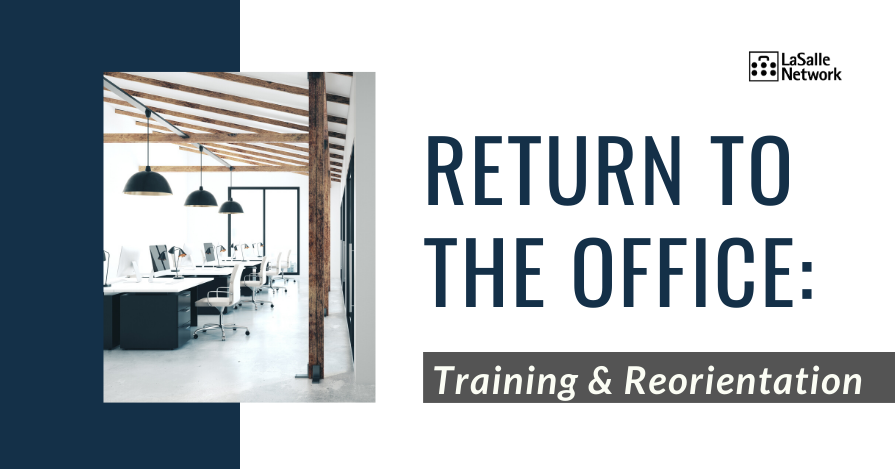As cities begin to reopen and companies plan for work in the new normal, consider how to prepare employees for the changes to come. Whether it be changes to the physical office space, policies, or adjustments to their roles, business will likely look different for the foreseeable future and require reorientation.
Consider hosting a virtual reorientation training for everyone at the organization to discuss expectations and changes before employees come back into the office, as well as address questions and concerns. Even if an organization has been on-site and is continuing with work as usual, repeated communication helps ensure clarity and can help improve employee performance, engagement and satisfaction.
Re-training may include topics such as, but not limited to…
- Office policies: Discuss any new expectations of how employees are to move about the office and use communal spaces, such as break rooms or restrooms. Consider giving a virtual office tour explaining new regulations.
- Disinfection standards: Discuss what the company is doing to maintain a safe and healthy office and the extra sanitization precautions that are being taken.
- Employee responsibility in sanitization: Establish what responsibilities employees may have in taking part in sanitization efforts. This may include personal hygiene and hand washing, wiping down of personal space or disinfecting communal surfaces after each use, depending on the company’s cleaning policies and procedures.
- Communication policies: Discuss the new communication ‘norm’ for the office when arriving back on–site, including whether meetings will continue virtually or if you will be utilizing conference rooms again. While employees may be tempted to pull up a chair to talk through projects or catch up by the water cooler, this may not be safe. Establish best practices for communicating company-wide information and communicating within a team, including chat, email and video conferencing.
- Wellness self-checks: Discuss how to properly conduct a daily wellness self-check and who to report to if you become ill.
- Wellness Checks: If your company will be doing on-site wellness screening, prepare employees for what to expect and what their rights and protections are. This may include a questionnaire or a temperature check before an employee is able to enter the office.
- Policies regarding PPE: What equipment is required to be worn by whom, and how will it be distributed to them? Include demonstrations of how to properly wear, wash or dispose of the PPE.
Ensure employees know what consequences will be if they do not adhere to these new policies and make it clear exactly what will be required of them. Consider giving a tentative timeline for how long company leadership may be expecting these policies to be upheld.
Consider hosting individualized team trainings to discuss specific policies that apply to various members within the organization. The following are a few of the teams and applicable topics that may require additional training.
Disinfection Team:
Brief your designated disinfection team on the new cleaning protocols and ensure the team is large enough to handle the increased demand. Train them on what approved cleaning products to use on which surfaces, and if they are suggested to wear PPE, such as gloves or a face covering, while cleaning. Designate a schedule for how frequently different areas will need to be disinfected and how they will record what they’ve cleaned.
Health Screening:
Train employees on what questions to ask regarding COVID-19 symptoms, how to use a no-touch thermometer and what to do if an employee presents with a temperature or reports experiencing symptoms. Many companies holding health screenings require those doing the screening to wear face coverings or gloves, so in this instance, the team would need proper training for using PPE, as well.
HR and Management:
This training can include handling concerns from staff, any updates to the attendance policy and work–from–home policy, and mental health training. Consider discussing best practices for recognizing depression and anxiety in employees and how to best support employees having difficulty.
Recruiters:
If your company is hiring, train recruiters and hiring managers on proper interview safety. If you will be conducting interviews virtually, consider hosting a separate training to cover best practices for video interviewing. Inform recruiters of additional safety and sanitization standards and consider encouraging them not to shake hands or come in close contact.
As a staffing partner for thousands of business across all industries, we’ve collaborated with company leaders across the country to gather extensive resources and solutions for safely returning employees to the workplace.





